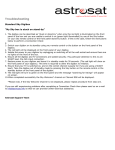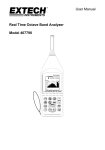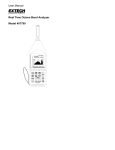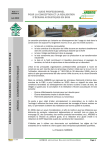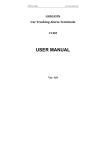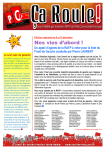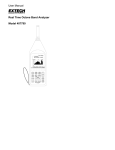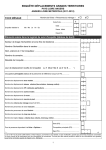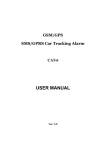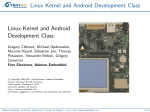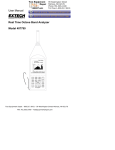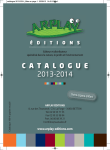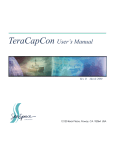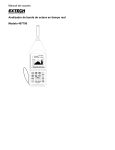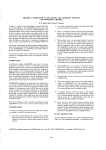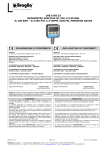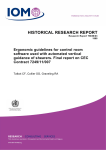Download AstroSAT 500
Transcript
.~'/:'-"; 1 -1" EADS t:~/ ..... a s r'LJm AstroSAT 500 Ret.: LXO-SP-OOOOS-DT-ASTA Issue: 2 Rev: 01 Date: 12/07/2010 Page 1 of 27 Li-ion BATTERY SPECIFICATION CI CODE: DRL Rets: Name and Function Date Valérie COSCULLUELA Prepared by AS250 Power Architect Checked by: Brigitte FOURNE Signature .1 l' 2.1 10 +( to(-o AS250 Avionics Electrical Architect Serge CAZALS Approved by: Authorised by: AS250 Avionics Product Assurance Manager Didier LOCHE Power MPC & Battery product focal point Christophe LEMERCIER Application Authorised by: .... Head of Astrium EQS Satellite product definition & implementation (AET6) EADS ASTRIUM CONFIDENTIAL Document Aulogenerated tram DOORS Module: IDIVAS-AS2S0/LeveI4/4.6 Ballery RS/U-Ion BATTERY ASSOO· AstroTerra - AstroSAT 500 Ref.: LXO-SP-00005-DT-ASTR Issue: 2 Rev: 01 Date: 12/07/2010 Page 2 of 27 INTENTIONALLY BLANK The copyright in this document is the property of EADS ASTRIUM SAS and the contents may not be reproduced or revealed to third parties without prior permission of that company in writing. © EADS Astrium AstroSAT 500 Ref.: LXO-SP-00005-DT-ASTR Issue: 2 Rev: 01 Date: 12/07/2010 Page 3 of 27 CONTENTS 1. INTRODUCTION AND SCOPE.....................................................................................................................7 1.1 Introduction.............................................................................................................................................7 1.2 Scope .....................................................................................................................................................7 1.3 Guidelines...............................................................................................................................................7 1.4 Summary Description .............................................................................................................................7 1.5 abbreviations and acronyms ..................................................................................................................8 2. DOCUMENTS................................................................................................................................................9 2.1 Applicable documents ............................................................................................................................9 2.2 Reference documents ............................................................................................................................9 3. FUNCTIONAL AND PERFORMANCE REQUIREMENTS..........................................................................10 3.1 Functional Requirements .....................................................................................................................10 3.1.1 Battery layout .............................................................................................................................10 3.1.2 Battery management ..................................................................................................................10 3.2 Performance Requirements .................................................................................................................10 3.2.1 Power and energy requirements ................................................................................................10 3.2.2 Battery charge management......................................................................................................10 3.2.3 Protections .................................................................................................................................11 3.2.4 Battery voltage range .................................................................................................................11 4. UNIT SPECIFIC DESIGN AND INTERFACE REQUIREMENTS ...............................................................12 4.1 Mechanical Design and Interface Requirements .................................................................................12 4.1.1 Mass...........................................................................................................................................12 4.1.2 Centre of Gravity ........................................................................................................................12 4.1.3 Envelope ....................................................................................................................................12 4.2 Thermal Design and Interface Requirements ......................................................................................12 4.2.1 Heat Dissipation .........................................................................................................................12 4.2.2 Unit Thermal Properties .............................................................................................................12 4.2.3 Temperature Requirements .......................................................................................................13 4.2.4 Thermal control ..........................................................................................................................13 4.3 Electrical Design and Interface Requirements .....................................................................................13 4.3.1 Power Consumption ...................................................................................................................13 4.3.2 Electrical Interface Description...................................................................................................13 4.3.3 Electrical insulation.....................................................................................................................15 4.4 Operational requirements.....................................................................................................................15 4.4.1 Mission profile ............................................................................................................................15 4.4.2 Reliability and availability ...........................................................................................................16 4.4.3 Safety .........................................................................................................................................18 4.4.4 Identification and marking ..........................................................................................................18 5. GENERAL DESIGN AND INTERFACE REQUIREMENTS ........................................................................20 6. VERIFICATION REQUIREMENTS .............................................................................................................21 7. PRODUCT ASSURANCE REQUIREMENTS .............................................................................................22 The copyright in this document is the property of EADS ASTRIUM SAS and the contents may not be reproduced or revealed to third parties without prior permission of that company in writing. © EADS Astrium AstroSAT 500 Ref.: LXO-SP-00005-DT-ASTR Issue: 2 Rev: 01 Date: 12/07/2010 Page 4 of 27 TABLES Table 4.3-1: Connector List .............................................................................................................................14 Table 4.3-2: pin function available at power interface .....................................................................................14 The copyright in this document is the property of EADS ASTRIUM SAS and the contents may not be reproduced or revealed to third parties without prior permission of that company in writing. © EADS Astrium AstroSAT 500 Ref.: LXO-SP-00005-DT-ASTR Issue: 2 Rev: 01 Date: 12/07/2010 Page 5 of 27 INTENTIONALLY BLANK The copyright in this document is the property of EADS ASTRIUM SAS and the contents may not be reproduced or revealed to third parties without prior permission of that company in writing. © EADS Astrium AstroSAT 500 Ref.: LXO-SP-00005-DT-ASTR Issue: 2 Rev: 01 Date: 12/07/2010 Page 6 of 27 SUMMARY The copyright in this document is the property of EADS ASTRIUM SAS and the contents may not be reproduced or revealed to third parties without prior permission of that company in writing. © EADS Astrium AstroSAT 500 Ref.: LXO-SP-00005-DT-ASTR Issue: 2 Rev: 01 Date: 12/07/2010 Page 7 of 27 1. INTRODUCTION AND SCOPE 1.1 Introduction AstroSAT 500 refers to a family of satellite of the 500 kg class. It is designed to operate five years in Low Earth polar orbit at an altitude of about 700 km. The battery specified in this document is of the Li-Ion technology. 1.2 Scope The document in hand comprises the contractually relevant requirements and constraints for the AstroSAT 500 battery. This includes: •the performance as well as design and interface requirements of subject hardware •the product assurance requirements •the testing and verification requirements •the verification method ( Verif method) as one of the following : R/review of design; I/inspection; A/analysis; T/test, S/similarity, D/definition (not be tracked). 1.3 Guidelines Requirements within this document are shown in italic font. Each requirement is preceded by a summary line that contains the following fields, delimited by "/" •Doors requirement number. •Requirement number in the AstroSat 500 battery specification •Intended Verification method BAT_11 / / T,R The Doors Requirement Number has the form BAT_xxx/yyy/a,b/ where xxx is a unique number assigned consecutively, yyy is the requirement number in the AstroSat 500 specification and a,b are the intended verification methods. The Intended Verification Method codes are as follows : •R - Review •A - Analysis •I - Inspection •T - Test •S - Similarity The requirement text follows the summary line. If tables are considered as part of requirement they are referenced clearly in the text and inserted after and separated from the requirement and are managed as free text attached to the identifier requirement. All document elements not presented in the format explained above are not requirements and will not be verified or tracked. 1.4 Summary Description Battery is mainly needed during the launch phase, to support the solar array when its power capability is lower than the consumption and in case of contingency. The copyright in this document is the property of EADS ASTRIUM SAS and the contents may not be reproduced or revealed to third parties without prior permission of that company in writing. © EADS Astrium AstroSAT 500 Ref.: LXO-SP-00005-DT-ASTR Issue: 2 Rev: 01 Date: 12/07/2010 Page 8 of 27 The battery consists in the following items : •One structure for mechanical support and thermal dissipation, •Cells, •Temperature sensor for temperature telemetries, •Heaters, if applicable, •Connectors for electrical interface, Except otherwise specified, all requirements of the specification apply at battery level. 1.5 abbreviations and acronyms AI T Assemb ly Integ ra tio n & Test BO L Beg in nin g O f Life CO G Centre Of Gravity DO D Depth O f Discharge EO L End O f Life FDIR Failure De tectio n Isola tio n an d Recovery ICD Interfa ce Control Docum ent ML I Multi Layer Insulator SO C Sta te O f Ch arge SE U Single E ve nt Upset TBC To B e Conf irme d TBD To B e Defined The copyright in this document is the property of EADS ASTRIUM SAS and the contents may not be reproduced or revealed to third parties without prior permission of that company in writing. © EADS Astrium AstroSAT 500 Ref.: LXO-SP-00005-DT-ASTR Issue: 2 Rev: 01 Date: 12/07/2010 Page 9 of 27 2. DOCUMENTS 2.1 Applicable documents The following documents are applicable documents to this specification. Only those parts of them are applicable for the contractors product design, test and manufacturing which are distinctly made transparent by references within this specification. [AD 01] LXO.SP.0009.MMS-T Product Assurance Requirements [AD 02] LXO.SP.0005.MMS-T Unit Requirement Document [AD 03] LXO.SOW.00002.DT.ASTR Bus Statement Of Work for delivery of Li-ion Battery for AstroSAT 500 2.2 Reference documents The copyright in this document is the property of EADS ASTRIUM SAS and the contents may not be reproduced or revealed to third parties without prior permission of that company in writing. © EADS Astrium AstroSAT 500 Ref.: LXO-SP-00005-DT-ASTR Issue: 2 Rev: 01 Date: 12/07/2010 Page 10 of 27 3. FUNCTIONAL AND PERFORMANCE REQUIREMENTS 3.1 Functional Requirements 3.1.1 Battery layout BAT_38 / 3005 / R The battery shall be made of one module such as to comply with all the performance requirements. 3.1.2 Battery management BAT_40 / 3015 / R The battery functional management shall be performed at battery level. BAT_41 / 3020 / T,R Battery charge shall be ensured in two steps : Charge at maximum available current, limited to a fixed value until a voltage limit is reached Once the battery voltage limit is reached, charge at this voltage until the end of the sunlight phase 3.2 Performance Requirements 3.2.1 Power and energy requirements BAT_44 / 3025 / R The battery shall withstand the following cycle definition along its complete life time. Average discharge power : 418 W during 33,5 min Average available charge current : 10 A during 67,8 min BAT_45 / 3030 / T,R The battery shall provide 1 215 Wh under an average power consumption of 250 W during the spacecraft launch and until charge is started. BAT_46 / 3035 / R The battery shall always keep a minimum of 555 Wh reserve energy under an average power consumption of 265 W, along its complete life time, with the exception of the launch phase, for spacecraft safe mode acquisition. BAT_47 / 3040 / R The battery shall provide a peak power capability of 750 W in discharge over a duration of 6 seconds. 3.2.2 Battery charge management BAT_49 / 3045 / T,R The battery shall be current limited in charge at 37,5 A. The limitation shall not be done at battery level but at System level. BAT_50 / 3050 / T,R The battery shall be voltage limited at 33.6 V -0,+0.4 V . The limitation shall not be done at battery level but at System level. The copyright in this document is the property of EADS ASTRIUM SAS and the contents may not be reproduced or revealed to third parties without prior permission of that company in writing. © EADS Astrium AstroSAT 500 Ref.: LXO-SP-00005-DT-ASTR Issue: 2 Rev: 01 Date: 12/07/2010 Page 11 of 27 BAT_51 / 3052 / T,R The battery shall be able to withstand an abnormal charge current of 37,5 A during 100 ms , fifty times in life time, whatever the battery SOC is. 3.2.3 Protections BAT_53 / 3055 / T,R Double insulation shall be implemented in order to avoid any short circuit (including connectors) in case of single failure. 3.2.4 Battery voltage range BAT_55 / 3060 / T,R The battery voltage range shall be between 24 V and 34 V when used according to sections 3.2.1 to 3.2.3. The copyright in this document is the property of EADS ASTRIUM SAS and the contents may not be reproduced or revealed to third parties without prior permission of that company in writing. © EADS Astrium Ref.: LXO-SP-00005-DT-ASTR Issue: 2 Rev: 01 AstroSAT 500 Date: 12/07/2010 Page 12 of 27 4. UNIT SPECIFIC DESIGN AND INTERFACE REQUIREMENTS 4.1 Mechanical Design and Interface Requirements 4.1.1 Mass BAT_59 / 4015 / T The overall battery mass in flight configuration shall be ≤ 20.8 kg, without interconnecting harness. This shall be verified by mass measurement on the fully assembled unit. 4.1.2 Centre of Gravity BAT_61 / 4020 / T,A The Centre of Gravity (CoG) w.r.t. the unit reference hole shall be provided. This shall be derived from a CoG measurement on the fully assembled unit. 4.1.3 Envelope BAT_63 / 4025 / T The battery including mounting feet and connectors shall not exceed the following dimensions (Width x Depth x Height): 295 mm x 355 mm x 180 mm This shall be verified by dimension measurement. 4.2 Thermal Design and Interface Requirements 4.2.1 Heat Dissipation BAT_66 / 4030 / T,R According to the energy and power cycle requirements of section 3.2.1, the battery dissipation shall not exceed the following range : -10°C Max. Dissipation averaged over one orbit: 0°C 15°C≤ <40°C 14 W 9W 5,5 W Max. Dissipation averaged over the discharge : 26 W 22 W 16 W Above figures shall be verified in frame of unit functional testing with an accuracy of the measured value of better than 5%. 4.2.2 Unit Thermal Properties BAT_68 / 4035 / R The battery shall not be allowed to exchange heat by radiation. The battery shall be covered by MultiLayer Insulator (MLI). BAT_69 / 4040 / R The battery heat exchange shall be done only by conduction through its base plate. BAT_70 / 4045 / R The battery base plate to satellite structure thermal conductivity will be better than 400 W/°C/m² (TBC). BAT_71 / 4050 / R The battery thermal design shall assume a maximum temperature gradient of the base plate of 2 °C. The copyright in this document is the property of EADS ASTRIUM SAS and the contents may not be reproduced or revealed to third parties without prior permission of that company in writing. © EADS Astrium AstroSAT 500 Ref.: LXO-SP-00005-DT-ASTR Issue: 2 Rev: 01 Date: 12/07/2010 Page 13 of 27 4.2.3 Temperature Requirements BAT_73 / 4055 / T The applicable unit temperature limits are: Operating Temperature Limits: 0 °C to +30 °C Extended Operating Temperature Limits: -10 °C to +40 °C Note 1 Qualification Temperature Limits: -20 °C (TFQ min) to +50 °C (TFQ max) Note 2 Non operating Temperature Limits: -30 °C (TNF min) to +55 °C (TNF max) Average Temperature (life time): ≤ +20 °C This shall be verified by thermal testing as specified in AD 02 Note 1: The cumulative time for these extended range shall not exceed 1000 (TBC) Charge /discharge cycles as per 3025 ; Any performance which cannot be met shall be identified and justified. Note 2: This is the Qualification range to be applied during the Thermal Vacuum tests. Full performance is not required between [-10 °C to 0 °C] and [+30 °C to +50 °C] 4.2.4 Thermal control BAT_75 / 4060 / R The battery shall be equipped with thermal heaters and thermal sensors that will make possible its temperature control by the On-Board Computer. The battery shall be fitted with a redundant thermal heater and three thermal sensors used for regulation (1 nominal, 1 redundant and 1 for monitoring). BAT_76 / 4066 / R The thermal heaters locations are under the subcontractor responsibility . R > 40 ohms in the extended operating temperature range, ESCC4009/002 Double layer heater recommended. Remark: The power switching frequency shall be 1/8 Hz maximum 4.3 Electrical Design and Interface Requirements 4.3.1 Power Consumption BAT_79 / 4070 / R The battery shall not require any primary power supply. 4.3.2 Electrical Interface Description 4.3.2.1 Connectors BAT_82 / 4075 / R The battery shall be equipped with connectors in accordance with the following connector list. The copyright in this document is the property of EADS ASTRIUM SAS and the contents may not be reproduced or revealed to third parties without prior permission of that company in writing. © EADS Astrium Ref.: LXO-SP-00005-DT-ASTR Issue: 2 Rev: 01 AstroSAT 500 Date: 12/07/2010 Page 14 of 27 Connector number Connector type Connector function J01 DCMA 8W8S Power (Positive lines) ESCC3401/001 J04 DCMA 5W5S Power (Negative lines) ESCC3401/001 J02 D*M* 9P Heater supply ESCC3401/001 or 002 J03 D*M* 25S Telemetries ESCC3401/001 or 002 Table 4.3-1: Connector List 4.3.2.2 Power interface BAT_86 / 4080 / R The battery power interface shall consist of 10 AWG12 wires: 5 (positive lines)+5(negative lines). The wiring of both polarities lines shall be done to minimise as far as possible magnetic momentum. For power interface (J01) which includes more than 5 pins, all the pins shall be externally connected to positive power lines. BAT_732 / 4135 / R The pin allocation shall be as in Table 4.3-2. Power Interface (J01): Pins 1,2,3,4,5,6,7,8 (+) Power Interface (J04): Pins 1,2,3,4,5 (-) Table 4.3-2: pin function available at power interface BAT_734 / 4145 / Deleted BAT_87 / 4085 / T,R The battery internal impedance AC on the power interface shall be: •Lower than 20 mΩ for frequencies ≤ 1 kHz and •Lower than 60 mΩ for frequencies at 10 kHz. This applies for 100% SOC at Tamb = 22 ±3 °C And Lbatt : 110 nH for frequencies ≤ 10 kHz , Tamb ≥ 0 °C and at 100% SOC The copyright in this document is the property of EADS ASTRIUM SAS and the contents may not be reproduced or revealed to third parties without prior permission of that company in writing. © EADS Astrium AstroSAT 500 Ref.: LXO-SP-00005-DT-ASTR Issue: 2 Rev: 01 Date: 12/07/2010 Page 15 of 27 BAT_88 / 4086 / T,A,R The battery internal impedance DC on the power interface shall be lower than BOL : 40 mΩ for frequencies ≤ 1 kHz , T=0 °C , 100% SOC EOL: 120 mΩ for frequencies ≤ 1 kHz , T=0 °C , SOC Min (Vcell = 3.0 V) 4.3.2.3 Heater interface BAT_90 / 4090 / R The battery heater supply interface shall consists in 2 pairs of AWG20 wires. BAT_91 / 4095 / R The battery heater shall be supplied with a non-regulated 22 to 35 V power bus, protected by current limiters. 4.3.2.4 Battery voltage monitoring BAT_708 / 4115 / R Each battery module shall provide two battery voltage monitoring signals BAT_709 / 4120 / R The characteristics of the battery voltage monitoring interface shall be as follows : • Voltage range : battery voltage • Protection by resistance located in the battery : 12.1 kΩ ± 0.02%, 1/4 W 4.3.2.5 Temperature monitoring BAT_711 / 4125 / R Each battery module shall provide 3 temperature monitoring signals, in addition to these required in section 4.2.4 BAT_712 / 4130 / T,R The characteristics of the temperature monitoring interface for the battery shall be as defined in [AD 02] requirements 4370 and 4380 (Betatherm - 15KOhm @25°C) 4.3.3 Electrical insulation BAT_93 / 4140 / T,A The impedance between any cell of the battery and its chassis shall be greater than 100 MΩ under 250 V to avoid any cell voltage drift. 4.4 Operational requirements 4.4.1 Mission profile 4.4.1.1 Lifetime Refer to AD02. The copyright in this document is the property of EADS ASTRIUM SAS and the contents may not be reproduced or revealed to third parties without prior permission of that company in writing. © EADS Astrium AstroSAT 500 Ref.: LXO-SP-00005-DT-ASTR Issue: 2 Rev: 01 Date: 12/07/2010 Page 16 of 27 4.4.1.2 Duty cycle BAT_99 / 4150 / T,A The battery shall be designed to withstand 100 charge/discharge (see conditions) cycles over the ground storage period and 28000 charge/discharge over the 5 years mission lifetime (nominal operations) in orbit BAT_100 / 4151 / T,A The battery design shall be such that EOL performances meet requirement 4150 and cumulative effects of: •3 years of storage under the conditions as per the User Manual •2 years of AIT with an average SOC of 50% in tapering at 20°C •3 capacity measurements (100% DoD at 20°C) 4.4.2 Reliability and availability 4.4.2.1 Reliability BAT_103 / 4155 / A The probability of success (full achievement of the battery functions and the related performances) of the battery over 5 years shall be better than 0,99 considering the specified in-orbit duty cycle and considering the nominal environment of the battery. 4.4.2.2 Availability BAT_105 / 4160 / T,A The probability of occurrence of SEU whose effects lead to an outage of the main battery functions shall be less than 2 10-5/day (the estimation shall take into account a minimum of 2 Solar flares during the 5 years in orbit). 4.4.2.3 Failure modes analysis The objectives and the assumptions of the FMECA are described in the PA generic requirements, section RAMS. Failure propagation definition A failure occurring on a function FA propagates on the function FB when the failure on function FA leads •To stress the function FB permanently with a level higher than the derating level, •To stress the function FB temporarily with a level higher than the manufacturer rating. •To physically damage the function FB (pollution, destruction, …). The term permanently means that no action is initiated in order to control (eliminate) the failure. The failure remains active at each switching on of the function. BAT_114 / 4170 / A For the electrical and thermal interfaces the levels to be respected in case of failure shall be the nominal levels specified in the technical specification, unless specific levels are specified. Severity scale BAT_116 / 4175 / A The failure modes and effects analysis of the battery shall consider the following severity scale: The copyright in this document is the property of EADS ASTRIUM SAS and the contents may not be reproduced or revealed to third parties without prior permission of that company in writing. © EADS Astrium AstroSAT 500 Ref.: LXO-SP-00005-DT-ASTR Issue: 2 Rev: 01 Date: 12/07/2010 Page 17 of 27 1- Failure propagation outside the battery (power bus, …) 2- Degradation of the battery functions a- n/a b- n/a c- n/a d- Availability target not respected (outages on occurrence of transient phenomenon, …) e- Degradation of the battery performances (sensors, …) 3- Effect leading to minor impact on the mission (latent failure on protection devices, …) 4- Effect without any operational impacts (telemetry not used for operate the battery, …) 4.4.2.4 Design rules BAT_118 / 4180 / A The battery strings shall be physically separated and no string failure shall propagate to another string through thermal means. BAT_119 / 4185 / A The failures which are likely to propagate (see definition) shall be controlled (which means either the failure is eliminated through redundancy, or the unit is placed into a safe state in which the propagation is no longer active) •Control through internal redundancy if the time for avoiding failure propagation is immediate, •Control through hardwired automatism if the time for avoiding propagation is less than 10 s (TBC), •Control through On-Board Software if the time for avoiding propagation is compliant with the time to react of the On-Board Software (i.e. higher than 10 s). These failures shall be detectable through battery data transmitted to the on-Board Software and the adequate resources needed to switch the battery in a safe state (i.e. no failure propagation) shall not be affected by the failure. BAT_120 / 4190 / A The battery elements shall be tolerant to SEU (no physical damage) BAT_121 / 4195 / A The battery elements shall not be latch-up sensitive BAT_122 / 4200 / A The battery shall achieve all its nominal (EOL) performances despite the in-orbit cumulated radiations dose as specified in AD 02. BAT_123 / 4205 / A The battery shall respect all design rules specified in AD 02 regarding interface connections, crossstrapping links and FDIR features. 4.4.2.5 Single Point Failure (SPF) BAT_125 / 4210 / A No single failure within the battery shall lead to open circuit on more than one battery string. The copyright in this document is the property of EADS ASTRIUM SAS and the contents may not be reproduced or revealed to third parties without prior permission of that company in writing. © EADS Astrium AstroSAT 500 Ref.: LXO-SP-00005-DT-ASTR Issue: 2 Rev: 01 Date: 12/07/2010 Page 18 of 27 BAT_126 / 4215 / A No single failure within the battery shall lead to a short-circuit within the battery or within any of the strings. BAT_127 / 4220 / A No single failure within the battery shall lead to the loss of the battery management BAT_128 / 4225 / A No single failure within the battery shall lead to failure propagation outside the battery (voltage, ..) BAT_129 / 4226 / A No single failure within the battery shall lead to battery voltage below 23 V, including transients. BAT_130 / 4230 / A No single failure within the battery shall lead to permanent thermal dissipation 10% above maximum specified dissipated power specified in requirement 4030. 4.4.2.6 Feared events This section addresses some specific events identified in the system risk analysis and specifies the related requirements. BAT_133 / 4250 / A The battery shall be able to withstand: a) 19V minimum for 500 ms (TBC) without damage b) 24 V to 20 V minimum voltage during 20 min with average power of 265 W @ 0°C min c) 20V minimum voltage with no current for indefinite time. 4.4.3 Safety BAT_135 / 4300 / A The battery shall be designed in order to avoid any hazard once the battery is packaged. BAT_136 / 4302 / A The battery shall be designed in order to include an on-ground protection on the top side of the battery, to avoid any electrical hazard once the battery is packaged. The design of this protection shall be submitted to prime for approval (with Mechanical ICD).The protection is for on-ground operation only and will not be submitted to Thermal vacuum and vibration. 4.4.4 Identification and marking BAT_138 / / R The unit hardware shall be marked by a nameplate in order to achieve configuration traceability. The identification shall be made by a label containing the following information: •Project Name : AstroSAT 500 •Unit Name / Model : BAT EM/PFM/FM2/… (*) •PT Item Code: : TBD •Serial Number : TBD by supplier •Drawing Number : TBD by supplier The copyright in this document is the property of EADS ASTRIUM SAS and the contents may not be reproduced or revealed to third parties without prior permission of that company in writing. © EADS Astrium AstroSAT 500 Ref.: LXO-SP-00005-DT-ASTR Issue: 2 Rev: 01 Date: 12/07/2010 Page 19 of 27 Individual unit shall be marked with a serial number. For standard parts and where the physical size of an item precludes identification of the hardware itself, a 'bag and label' technique shall be used (up to final integration). (*) as appropriate The copyright in this document is the property of EADS ASTRIUM SAS and the contents may not be reproduced or revealed to third parties without prior permission of that company in writing. © EADS Astrium AstroSAT 500 Ref.: LXO-SP-00005-DT-ASTR Issue: 2 Rev: 01 Date: 12/07/2010 Page 20 of 27 5. GENERAL DESIGN AND INTERFACE REQUIREMENTS Refer to AD 02. The copyright in this document is the property of EADS ASTRIUM SAS and the contents may not be reproduced or revealed to third parties without prior permission of that company in writing. © EADS Astrium AstroSAT 500 Ref.: LXO-SP-00005-DT-ASTR Issue: 2 Rev: 01 Date: 12/07/2010 Page 21 of 27 6. VERIFICATION REQUIREMENTS Refer to AD 02 and AD 03 for generic verification requirements. The copyright in this document is the property of EADS ASTRIUM SAS and the contents may not be reproduced or revealed to third parties without prior permission of that company in writing. © EADS Astrium AstroSAT 500 Ref.: LXO-SP-00005-DT-ASTR Issue: 2 Rev: 01 Date: 12/07/2010 Page 22 of 27 7. PRODUCT ASSURANCE REQUIREMENTS Refer to AD 01. The copyright in this document is the property of EADS ASTRIUM SAS and the contents may not be reproduced or revealed to third parties without prior permission of that company in writing. © EADS Astrium AstroSAT 500 Ref.: LXO-SP-00005-DT-ASTR Issue: 2 Rev: 01 Date: 12/07/2010 Page 23 of 27 CHANGE LOG Note: This log is autogenerated from Doors. Special symbols may not be rendered correctly and hence the main body of the document shall always take precedence for requirements. Thus it should only be used as a guide to the modifications in the document and not as a substitute. Modified Objects In the following table modifications to the Object Text attribute are shown using red line markup. For other attributes the new value and the old value are shown in separate columns. The codes used in the object type (OT) column are: Rq = Requirement, Inf = Information, Hd = Heading, Ah = Applicability Matrix Heading, Ar = Applicability Matrix Requirement Identifier Attribute OT New Text Old Text BAT_86 Object Text Rq The battery power interface shall consist of 810 AWG12 wires: 45 section (positive lines)+45(negative lines). The wiring of both polarities lines shall be done to minimise as far as possible magnetic momentum. 4.3.2.2 BAT_732 Object Text Rq The pin allocation isshall listedbe as in Table 4.3-2. section 4.3.2.2 BAT_733 OLE Inf Figure/Table modified section 4.3.2.2 BAT_734 Object Text Rq The pins which are not used in Table 4.3-2 shall be double insulated with no possibility of electrical charge on these pins. Deleted section 4.3.2.2 BAT_734 Intended Rq R section Verification 4.3.2.2 Method Inserted Objects Identifier BAT_791 section 4.3.2.2 BAT_793 section 8.1 BAT_796 section 8.1 Object Type Information Text For power interface (J01) which includes more than 5 pins, all the pins shall be externally connected to positive power lines. TBD 02/01 TBD Connector pins update Deleted Objects 9 differences found The copyright in this document is the property of EADS ASTRIUM SAS and the contents may not be reproduced or revealed to third parties without prior permission of that company in writing. © EADS Astrium AstroSAT 500 Ref.: LXO-SP-00005-DT-ASTR Issue: 2 Rev: 01 Date: 12/07/2010 Page 24 of 27 Requirement/Section Cross Reference Page numbers are the pages where the sections start BAT_11 .............. 1.3....................7 BAT_38 .............. 3.1.1.................10 BAT_40 .............. 3.1.2.................10 BAT_41 .............. 3.1.2.................10 BAT_44 .............. 3.2.1.................10 BAT_45 .............. 3.2.1.................10 BAT_46 .............. 3.2.1.................10 BAT_47 .............. 3.2.1.................10 BAT_49 .............. 3.2.2.................10 BAT_50 .............. 3.2.2.................10 BAT_51 .............. 3.2.2.................10 BAT_53 .............. 3.2.3.................11 BAT_55 .............. 3.2.4.................11 BAT_59 .............. 4.1.1.................12 BAT_61 .............. 4.1.2.................12 BAT_63 .............. 4.1.3.................12 BAT_66 .............. 4.2.1.................12 BAT_68 .............. 4.2.2.................12 BAT_69 .............. 4.2.2.................12 BAT_70 .............. 4.2.2.................12 BAT_71 .............. 4.2.2.................12 BAT_73 .............. 4.2.3.................13 BAT_75 .............. 4.2.4.................13 BAT_76 .............. 4.2.4.................13 BAT_79 .............. 4.3.1.................13 BAT_82 .............. 4.3.2.1..............13 BAT_86 .............. 4.3.2.2..............14 BAT_87 .............. 4.3.2.2..............14 BAT_88 .............. 4.3.2.2..............14 BAT_90 .............. 4.3.2.3..............15 BAT_91 .............. 4.3.2.3..............15 BAT_93 .............. 4.3.3.................15 BAT_99 .............. 4.4.1.2..............16 BAT_100 ............ 4.4.1.2..............16 BAT_103 ............ 4.4.2.1..............16 BAT_105 ............ 4.4.2.2..............16 BAT_114 ............ 4.4.2.3..............16 BAT_116 ............ 4.4.2.3..............16 BAT_118 ............ 4.4.2.4..............17 BAT_119 ............ 4.4.2.4..............17 BAT_120 ............ 4.4.2.4..............17 BAT_121 ............ 4.4.2.4..............17 BAT_122 ............ 4.4.2.4..............17 BAT_123 ............ 4.4.2.4..............17 BAT_125 ............ 4.4.2.5..............17 BAT_126 ............ 4.4.2.5..............17 BAT_127 ............ 4.4.2.5..............17 BAT_128 ............ 4.4.2.5..............17 BAT_129 ............ 4.4.2.5..............17 BAT_130 ............ 4.4.2.5..............17 BAT_133 ............ 4.4.2.6..............18 BAT_135 ............ 4.4.3.................18 BAT_136 ............ 4.4.3.................18 BAT_138 ............ 4.4.4.................18 BAT_708 .............4.3.2.4 ............. 15 BAT_709 .............4.3.2.4 ............. 15 BAT_711 .............4.3.2.5 ............. 15 BAT_712 .............4.3.2.5 ............. 15 BAT_732 .............4.3.2.2 ............. 14 BAT_734 .............4.3.2.2 ............. 14 The copyright in this document is the property of EADS ASTRIUM SAS and the contents may not be reproduced or revealed to third parties without prior permission of that company in writing. © EADS Astrium AstroSAT 500 Ref.: LXO-SP-00005-DT-ASTR Issue: 2 Rev: 01 Date: 12/07/2010 Page 25 of 27 DOCUMENT CHANGE DETAILS ISSUE 01 02 02/01 CHANGE AUTHORITY CLASS RELEVANT INFORMATION/INSTRUCTIONS Initial release (07/05/09) Consistency with AS500 specification Is02, impedance change Connector pins update The copyright in this document is the property of EADS ASTRIUM SAS and the contents may not be reproduced or revealed to third parties without prior permission of that company in writing. © EADS Astrium Ref.: LXO-SP-00005-DT-ASTR Issue: 2 Rev: 01 AstroSAT 500 Date: 12/07/2010 Page 26 of 27 DISTRIBUTION LIST Corporate use Document internal Classification Project Limited Controlled Configured X Astrium AS250 Avionics Team X Distribution Astrium AS250 Avionics Team BARADAT Pierre LEBREDONCHEL Jerome BILLIEN Jean Luc MARCILLE Herve BONNEAU Celine MARTINEZ Alain CAZALS Serge X CHUPIN Stephane COSCULLUELA Valerie X PALOUS Jean-Claude DEFENDINI Ange FOURNE Brigitte Distribution X POQUET GOURDON X PREVOT Sylvain GALLAND Philippe TABOUELLE Alain GENTY Patrick TEOFILI Fabrice GILLOT Bernard THIBAUD Pierre GUIONNET Pascal PENALVA Sonia X FAVREAU Michel AS250 Documentation X LEBLOND Philippe AS250 Configuration manager X Astrium Product Policy Distribution Astrium AstroTerra BARABOTTI Laurent X ALARY Sébastien LEMERCIER Christophe X BELLEAU Patrick PITZ Wolfgang X BORDE Jacques Astrium MPC ALCINDOR Peter Distribution X BOUSQUET Christophe X DAREL Anthony X HAMEURY Olivier BALDWIN Robert PONCIN Thierry BARRIERE Jacques SIGUIER Michel BERTHELIER David VIVIER Jean Maurice CAMILLERI Stephane ASTROTERRA X DEBUS Volker ASTROTERRA Configuration X JANVIER Michel OESTERLE Eduard The copyright in this document is the property of EADS ASTRIUM SAS and the contents may not be reproduced or revealed to third parties without prior permission of that company in writing. © EADS Astrium AstroSAT 500 Astrium Product Policy Distribution Ref.: LXO-SP-00005-DT-ASTR Issue: 2 Rev: 01 Date: 12/07/2010 Page 27 of 27 Astrium AstroTerra Distribution SCHWAB Armin ECE Seosat Project Distribution Astrium CSO Project BORGES ALEJO Andrés X CORREGE Alain SANZ CUESTA Juan Andrés X GARCES Sylvain PERAN Francisco X JACOMOND Alain CORTES David LOCHE Didier LOPEZ Amador LUZURIER Jérôme BOURGEAL Silvia MONTEIL Denis GIL Miguel Angel SIBILLA Christian LIZONDO Jose Luis TOURNIER Thierry DE MIGUEL Elena Diana VILLEFRANCHE Patrice PALACIOS Cristina CSO Documentation SEOSAT Documentation X SEOSAT Configuration X Distribution GALLAND Philippe X LOCHE Didier X The copyright in this document is the property of EADS ASTRIUM SAS and the contents may not be reproduced or revealed to third parties without prior permission of that company in writing. © EADS Astrium



























